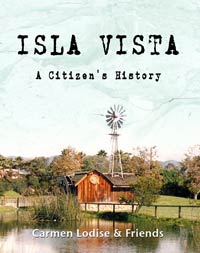New History of I.V. Published
Carmen Lodise and Friends Release Isla Vista: A Citizen's History
While sitting in on an Italian cinema class recently where professor Anna Brusutti dissected the final scenes of Fellini’s Satyricon (1968), I had an Isla Vista epiphany. In the film, young Romans are given a choice: eat from the corpses of their dead elders or leave forever. They choose to sail away; a scene Brusutti stressed reflected Fellini’s solidarity with ’60s rebellious youth. Raising my hand, I pointed out that Satyricon was playing at Isla Vista’s Magic Lantern Theatre the night the Bank of America was burned. Filmgoers walked out from Fellini’s countercultural sailors into 1960s apocalypse. Brusutti asked whether these UCSB students knew about the bank burning. About eight of the 50 raised their hands.

You might suppose this anecdote alone offers justification for Carmen Lodise’s big book, Isla Vista: A Citizen’s History. Who knew they didn’t know? Lodise, an activist and newspaper editor during the ’70s and ’80s, counters such ignorance with a political history beginning with Spaniards landing on the Chumash, segueing into the grandees of ranching, early (futile) oil explorations, and a conspiratorial-tinged saga of development, a story that fingers some big dead white men, like editor T.M. Storke, oil mogul Samuel Mosher, and former chancellor Robert Huttenback. Though its zoning and financing scandal accusations are surprisingly inconclusive, the story nonetheless feels both juicy and fishy.
Lodise offers essays on various uprisings, the bank’s demise (by Das Williams’s dad Malcolm), and, more scrupulously, limns I.V.’s political climate following the riots, a tale of much woe, in which the university, despite its own sponsored report’s recommendations, balked at fruitful involvement. It does slightly better today, Lodise admits. As disclosure, I am part of I.V. Arts, a UCSB-sponsored program promoting culture there. I also contributed reviews to Lodise’s newspaper.
In the book, Lodise invokes the hard work that produced, if not an incorporated city, fervent citizen involvement lasting more than two decades, a record of activism that created parks, public health facilities, a food co-op, and big fun, like nude-ins and joint-rolling contests. He also revives the voices of people we needed and still need: like playwright, professor, and activist Bob Potter; politically committed journalist and candidate Carrie Topliffe; artist and shopkeeper Al Plyley; and Lodise himself.

What his book doesn’t manage well, however, is the city’s complicated cultural life, ignoring things as disparate but important as off-beat cultural destinations like Biko House and public traumas such as the actions of David Attias, a disturbed young man who drove into a crowd of Isla Vistans and tragically killed four, but awakened, finally, the conscience of the university. Surfing, rock music, theater, poetry, even businesses born in I.V., like Kinko’s, get little shrift. The worst sleight, however, is Halloween, which, it has been well argued, did as much as firebrand Yippees to create the culture of protest there. With roots back to the late 1950s, Halloween bonfires, suspended during the psychedelic years, are truly the strongest tradition most I.V.ers remember. Lodise gives it one page.
It’s crucial to recall that Isla Vista is an adopted city. It’s a transient pleasure, partly because absent landlords rent 96 percent of the town out to students who spend maybe four years there, then leave. Though the town looks much as it did in the late 1960s, except the I.V. Bookstore, it is completely different. Few businesses last, and fewer citizens remain, including Lodise who lives in Mexico and Arizona today. The world he describes was what he saw; his adopted era.
You can’t blame Lodise for encouraging youth to continue speaking truth to power, to band together before I.V. becomes a theme park. But I can’t help thinking about Fellini’s sailors, offered the corpses of their elders to chew. Ironic that it’s now the boomers providing the eat-or-die flesh. This generation needs to know the past, sure, but not just 1970s legacies. A more balanced book may help us all move forward on all the available winds.
4•1•1
For more information or to order a copy of the book, visit islavistahistory.com.



